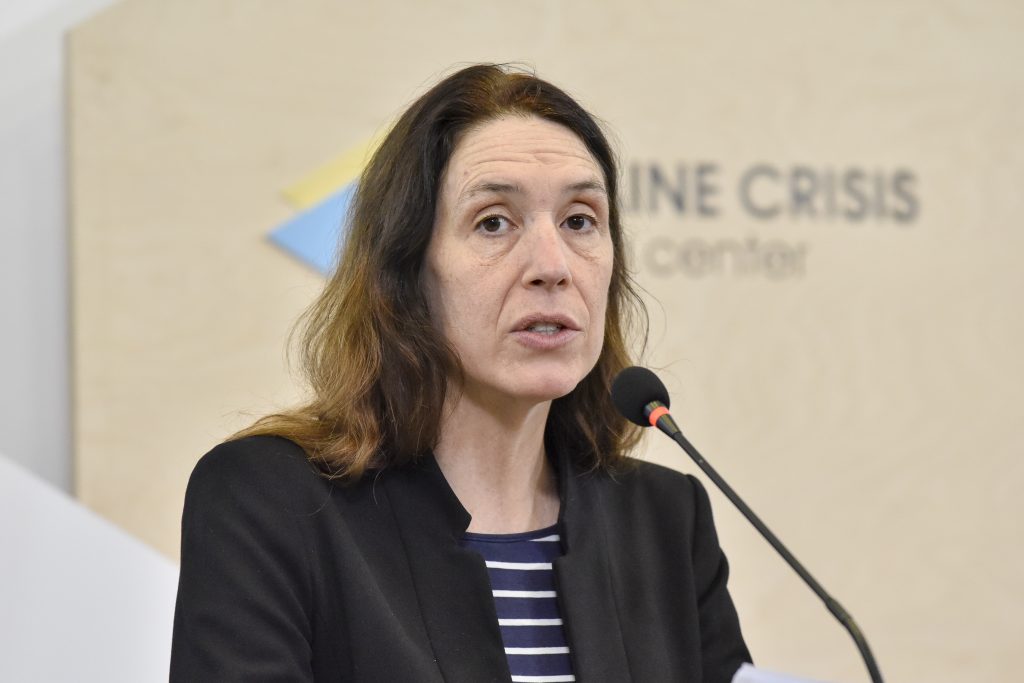8 civilians were killed and 60, including 9 children, injured due to hostilities in Eastern Ukraine between May 16 and August 15 2019, according to the 27th report of UN Human Rights Monitoring Mission in Ukraine. “We were concerned by the spike in civilian casualties in June and July. However, since the 21st of July recommitment to the ceasefire, civilian casualties have decreased dramatically. Since 21st of July we have recorded four civilians injured in the course of hostilities. Today, civilian casualties are the lowest for the entire conflict period, which has so far taken more than 3300 lives”, –noted Matilda Bogner, the Head of the UN Human Rights Monitoring Mission in Ukraine, at a press briefing at Ukraine Crisis Media Center.
Matilda Bogner said that the Mission is encouraged to hear that Ukraine’s new leadership seeks to enhance ties with people living across the contact line and in Crimea. “These aspirations must translate into concrete action.[…] Enhancing freedom of movement across the contact line and ensuring payment of pensions to all those eligible would be concrete measures. These efforts must be accompanied by accountability. People deserve justice for human rights violations committed against them. Accountability of perpetrators, regardless of the affiliation, and remedy and reparation for victims, regardless of their place of residence, will not only serve justice, but will also contribute to sustainable peace and reconciliation,” said Matilda Bogner.
She expressed the hope that the appointment of the new Chief Prosecutor General and the new Chief Military Prosecutor will give a boost to investigations of conflict-related and other grave human rights violations.
The UN Human Rights Monitoring Mission also calls Ukraine to ratify the Rome statute and to enable IDPs and labor migrants to vote in the scheduled 2020 local elections.
The report mentions the positive developments regarding the freedom of movement across the contact line; the recent disengagement in Stanytsia Luhanska and the planned reconstruction of the destroyed bridge; the creation of Civilian Casualties Mitigation Team and development of the National Strategy for the protection of civilians in armed conflict; the Cabinet of Ministers’ resolution on compensations to people whose houses have been destroyed, despite remarks to the document; annulment of the article of the Criminal Code which made pre-trial detention compulsory in conflict-related criminal cases.
Matilda Bogner also mentioned the transfer of over 300 pre-conflict prisoners from territory controlled by the so-called “LPR” to Government-controlled territory. She expressed hope that the similar transfer of prisoners from the territory controlled by the self-proclaimed “DPR” will be possible in the nearest future.
Matilda Bogner emphasized that the Mission still has no full access to the territories not controlled by Ukrainian Government.
“While we enjoy the freedom of operation in Government-controlled territory, including confidential access to places of detection and detainees, our operations have been severely restricted in armed group-controlled territory for more than a year. We continue to be denied access to places of detention and detainees, and remain gravely concerned about the conditions in detention and treatment of detainees”, Ms Bogner elaborated.
“In Crimea, the Russian Federation as the occupying power has still not granted us access to the peninsula in line with the UN General Assembly Resolutions on the territorial integrity of Ukraine,” she noted.
The report states that the number of searches and raids aimed at Crimean Tatars in the occupied Crimea during the first half of 2019 has doubled compared to the same period of 2018. The Russian Federation continues to transfer Crimean detainees to its territory. There are cases when people were accused of extremism for the content they posted on social media before the occupation in 2014.




